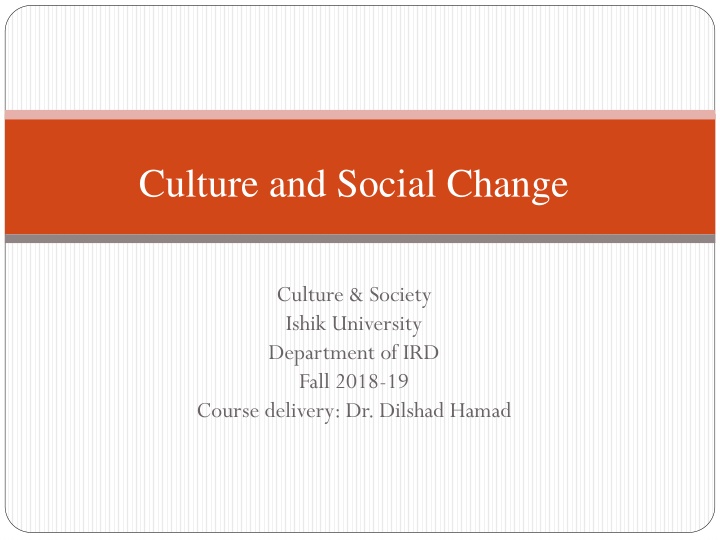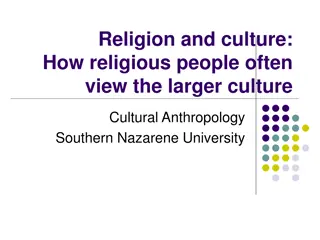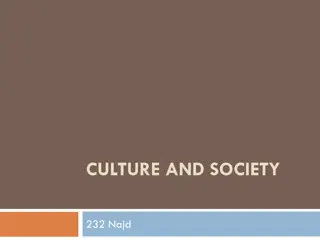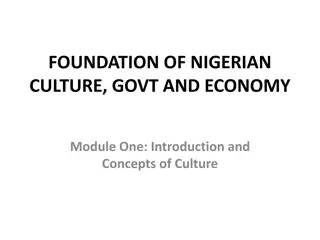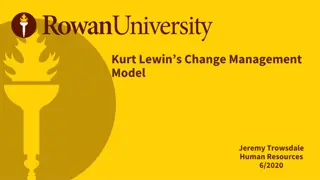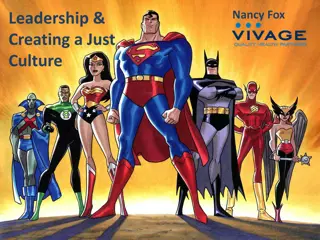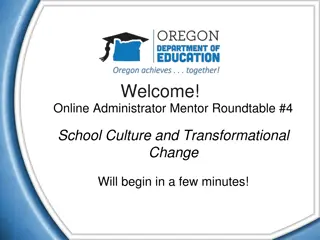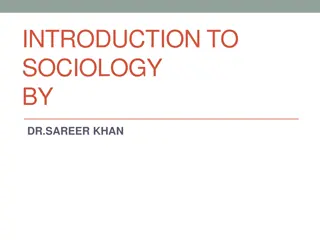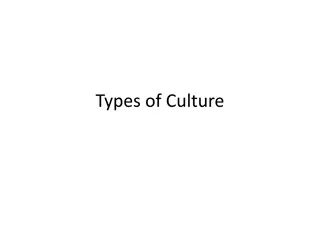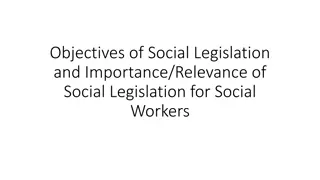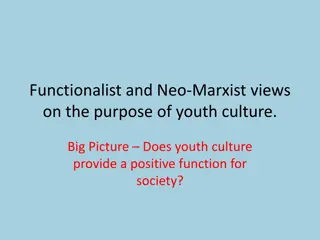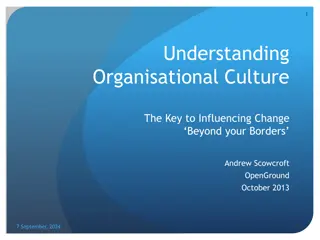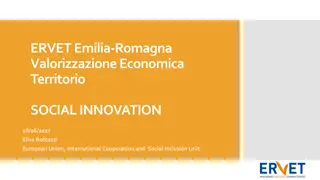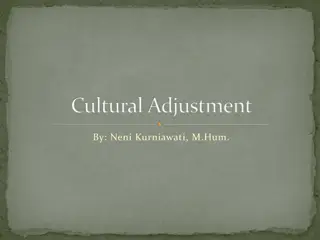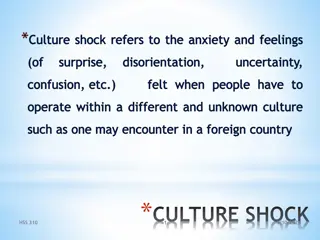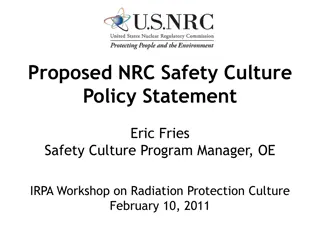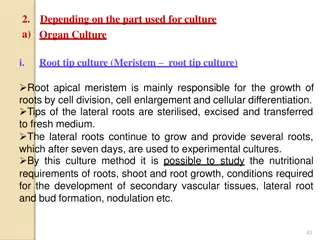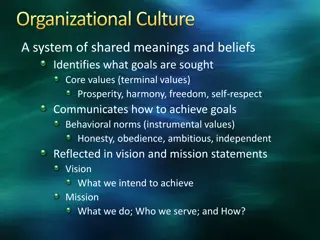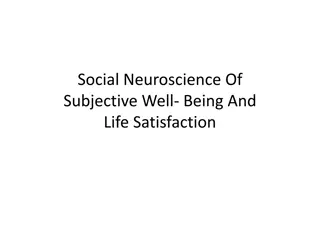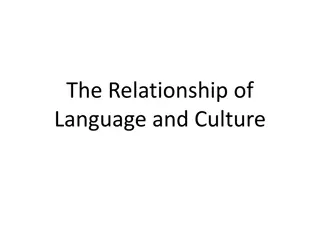Culture and Social Change
Examine shared beliefs, material vs. nonmaterial culture, cultural universals, ethnocentrism, and cultural relativism. Understand culture's role in society, explore its diversity, and analyze cultural change sources.
Download Presentation

Please find below an Image/Link to download the presentation.
The content on the website is provided AS IS for your information and personal use only. It may not be sold, licensed, or shared on other websites without obtaining consent from the author.If you encounter any issues during the download, it is possible that the publisher has removed the file from their server.
You are allowed to download the files provided on this website for personal or commercial use, subject to the condition that they are used lawfully. All files are the property of their respective owners.
The content on the website is provided AS IS for your information and personal use only. It may not be sold, licensed, or shared on other websites without obtaining consent from the author.
E N D
Presentation Transcript
Culture and Social Change Culture & Society Ishik University Department of IRD Fall 2018-19 Course delivery: Dr. Dilshad Hamad
Learning Objectives To understand culture and its function in society To explore a range of culture-related concepts (cultural universal, ethnocentrism, cultural relativism, xenocentrism and so forth) To explain cultural change and its main sources
Definition of Culture Shared beliefs, values, and practices, that participants must learn. Sociologically, we examine in what situation and context certain behavior is expected, and in which situations perhaps it is not. These rules are created and enforced by people who interact and share culture.
Material vs. Nonmaterial Culture Material culture refers to the objects or belongings of a group of people. Nonmaterial culture, in contrast, consists of the ideas, attitudes, and beliefs of a society
Material Culture Material Culture The things people construct Art Housing Clothing Music instruments Sports Food Nonmaterial Culture Nonmaterial Culture Beliefs, practices and values of a group of people Religion Government Laws/rules
Link of Material and Nonmaterial Culture Material Culture Nonmaterial culture Clothing, hairstyles, and jewelry are part of material culture. appropriateness of wearing certain clothing for specific events A school building belongs to material culture the teaching methods and educational standards
Cultural Universals Cultural universals are patterns or traits that are globally common to all societies. Examples include Family, funeral rites, weddings and celebration of birth, though each culture may view the ceremonies quite differently.
Ethnocentrism and Cultural Relativism Ethnocentrism evaluating another culture based on how it compares to one s own cultural Ethnocentrism, as sociologist William Graham (1906) described the term, involves a belief or attitude that one s own culture is better than all others. Cultural Relativism the practice of assessing a culture by its own standards rather than through the lens of one s own culture. and judging viewing it norms. Sumner
Cultural Imperialism and Xenocentrism cultural imperialism, the deliberate imposition of one s own cultural values on another culture. Xenocentrism is the opposite of ethnocentrism, and refers to the belief that another culture is superior to one s own.
Elements of Culture Values and Beliefs: 1. Values are a culture s standard for discerning what is good and just in society. Beliefs are the tenets or convictions that people hold to be true. Example: Americans commonly believe in the American Dream that anyone who works hard enough will be successful and wealthy.Underlying this belief is the American value that wealth is good and important. Ideal Culture---------------real Culture
Elements of Culture 2. Norms describe the visible and invisible rules of conduct through which societies are structured, or what sociologists call norms. Norms define how to behave in accordance with what a society has defined as good, right, and important, and most members of the society adhere to them. FormalVs. Non-Formal Norms
Mores and Folkways Mores (mor-ays) are norms that embody the moral views and principles of a group. Violating them can have serious consequences.E.g.Murder or Plagiarism folkways are norms without any moral underpinnings. Rather, folkways direct appropriate behavior in the day-to- day practices and expressions of a culture. E.g. to shaking hand with a friend, wearing a tie or a sandal when you go to an event an so on.
Elements of Culture 3. Symbols and Language Symbols such as gestures, signs, objects, signals, and words help people understand that world. They provide clues to understanding recognizable meanings that are shared by societies. Language is a symbolic system through which people communicate and through which culture is transmitted. Some languages contain a system of symbols used for written communication, while others communication and nonverbal actions. experiences by conveying rely on only spoken
Pop culture, subculture and cultural change High Culture and Popular Culture high culture to describe the pattern of cultural experiences and attitudes that exist in the highest class segments of a society. People often associate high culture with intellectualism,political power,and prestige. popular culture refers to the pattern of cultural experiences and attitudes that exist in mainstream society. Popular culture events might include a parade, a baseball game,or the season finale of a television show.
Subculture vs. Counterculture A subculture is a smaller cultural group within a larger culture; people of a subculture are part of the larger culture but also share a specific identity within a smaller group. Minority ethnic and religious groups,for example. countercultures, which are a type of subculture that rejects some of the larger culture s norms and values. In contrast to subcultures, which operate relatively smoothly within the larger society, countercultures might actively defy larger society by developing their own set of rules and norms to live by, sometimes even creating communities that operate outside of greater society.
Cultural Change Innovation: Discovery and Invention An innovation refers to an object or concept s initial appearance in society it s innovative because it is markedly new. There are two ways to come across an innovative object or idea: discover it or invent it. Discoveries make known previously unknown. Inventions result when something new is formed from existing objects or concepts when things are put together in an entirely new manner.
Cultural Change Diffusion and Globalization Globalization may be thought of initially as a widening, deepening and speeding interconnectedness in all aspects of contemporary life. up of world-wide diffusion, or the spread of material and nonmaterial culture. While globalization refers to the integration of markets, diffusion relates to a similar process in the integration of international cultures.
Theoretical Perspectives on Culture Functionalism: 1. Functionalists view society as a system in which all parts work or function together to create society as a whole. In this way, societies need culture to exist. Cultural norms function to support the fluid operation of society, and cultural values guide people in making choices. Just as members of a society work together to fulfill a society s needs, culture exists to meet its members basic needs.
Theoretical Perspectives on Culture 2. Conflict Theory: Conflict theorists view social structure as inherently unequal, based on power differentials related to issues like class, gender, race, and age. For a conflict theorist, culture is seen as reinforcing issues of "privilege" for certain groups based upon race,sex,class,and so on.Women strive for equality in a male- dominated society. Senior citizens struggle to protect their rights, their health care, and their independence from a younger generation of lawmakers.
Theoretical Perspectives on Culture 3. Symbolic Interactionism: is a sociological perspective that is most concerned with the face-to-face interactions between members of society. Interactionists see culture as being created and maintained by the ways people interact and in how individuals interpret each other s actions. Proponents of this theory conceptualize human interactions as a continuous process of deriving meaning from both objects in the environment and the actions of others.
